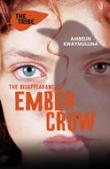
 3846014452575534636.jpeg
3846014452575534636.jpeg
Latest Issues
AbstractHistoryArchive Description
Sequel to the Tribe Book 1: The Interrogation of Ashala Wolf this follows the story of Ashala Wolf. 'To find her friend, Ashala Wolf must control her increasingly erratic and dangerous Sleepwalking ability and leave the Firstwood. But Ashala doesn’t realise that Ember is harbouring terrible secrets and is trying to shield the Tribe and all Illegals from a devastating new threat - her own past.' (Source: Publishers website)
Publication Details of Only Known VersionEarliest 2 Known Versions of
Works about this Work
-
Of Windows and Mirrors : Ambelin Kwaymullin's The Tribe Series, Transformative Fan Cultures and Aboriginal Eptistimologies
2017
single work
criticism
— Appears in: Westerly , vol. 62 no. 1 2017; (p. 110-124)Indigenous people lived through the end of the world, but we did not end, We survived by holding on to our cultures, our kin, and our sense of what was right in a world gone terribly wrong (Kwaymullina, 'Edges' 29)
'Young Adult Australian post-apocalyptic speculative fiction carries with it a number of expectations and tropes : that characters will exist in a dystopian, ruined landscape, that a lone teenager will rise up and rebel against institutionalised structures of repressive power; and that these youths will carry hope for the future in a destroyed world.' (Introduction)
-
[Review] The Disappearance of Ember Crow
2016
single work
review
— Appears in: Kirkus Reviews , 15 March vol. 84 no. 6 2016; (p. 432)
— Review of The Disappearance of Ember Crow 2013 single work novel'Six months after the events in series opener The Interrogation of Ashala Wolf (2014), the Tribe is thriving; then Ember Crow fails to return from a scouting mission, and Ashala and Connor, searching for answers, make a discovery that upends what they thought they knew about their friend and their own history.' (Publication abstract)
-
How Australian Dystopian Young Adult Fiction Differs from Its US Counterparts
2015
single work
column
— Appears in: The Conversation , 4 August 2015; 'For children and adolescents, the tyranny of adults can make any world dystopian. Real or fictional – no apocalypse required. But how does our Australian young adult fiction (of the dystopian variety) differ from that being produced in the US? And why do teenagers love dystopia so much?' (Introduction) -
The Disappearance of Ember Crow (The Tribe: Book 2)
2013
single work
review
— Appears in: Buzz Words , December 2013;
— Review of The Disappearance of Ember Crow 2013 single work novel
-
The Disappearance of Ember Crow (The Tribe: Book 2)
2013
single work
review
— Appears in: Buzz Words , December 2013;
— Review of The Disappearance of Ember Crow 2013 single work novel -
[Review] The Disappearance of Ember Crow
2016
single work
review
— Appears in: Kirkus Reviews , 15 March vol. 84 no. 6 2016; (p. 432)
— Review of The Disappearance of Ember Crow 2013 single work novel'Six months after the events in series opener The Interrogation of Ashala Wolf (2014), the Tribe is thriving; then Ember Crow fails to return from a scouting mission, and Ashala and Connor, searching for answers, make a discovery that upends what they thought they knew about their friend and their own history.' (Publication abstract)
-
How Australian Dystopian Young Adult Fiction Differs from Its US Counterparts
2015
single work
column
— Appears in: The Conversation , 4 August 2015; 'For children and adolescents, the tyranny of adults can make any world dystopian. Real or fictional – no apocalypse required. But how does our Australian young adult fiction (of the dystopian variety) differ from that being produced in the US? And why do teenagers love dystopia so much?' (Introduction) -
Of Windows and Mirrors : Ambelin Kwaymullin's The Tribe Series, Transformative Fan Cultures and Aboriginal Eptistimologies
2017
single work
criticism
— Appears in: Westerly , vol. 62 no. 1 2017; (p. 110-124)Indigenous people lived through the end of the world, but we did not end, We survived by holding on to our cultures, our kin, and our sense of what was right in a world gone terribly wrong (Kwaymullina, 'Edges' 29)
'Young Adult Australian post-apocalyptic speculative fiction carries with it a number of expectations and tropes : that characters will exist in a dystopian, ruined landscape, that a lone teenager will rise up and rebel against institutionalised structures of repressive power; and that these youths will carry hope for the future in a destroyed world.' (Introduction)





